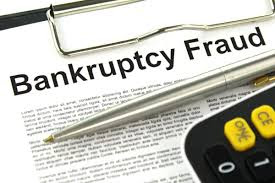
Understanding criminal By Behavioural Analysis and the Prevention of Fraud
When a detective searches for a suspect’s motive, the detective is using behaviourist methods of analysis. The detective assumes that the suspect was stimulated by some arrangement of factors. Many courses in criminology are built around the fundamental premise that crimes are particular sorts of behaviour and best understood as the product of operant conditioning. Fraud examiners often use the same methods in approaching a case. When money is missing, the fraud examiner traces the known flow of funds and then asks, “Who had the opportunity and the motive to get at this money?” Even without being conscious of the fact, the fraud examiner is performing a behaviourist analysis on the crime.
Ultimately, the question of fraud and behaviour comes down to this : what can we do about it?
We know that people commit these crimes at an
alarming rate. Incidents range from the clerk who skims a few hundred dollars
off a business’s daily deposits, to multimillion-dollar scam artists who
destroy entire organisations. There’s a world of difference between the skimming
clerk and the scamming financial executive, so can we even analyse the two people
within the same system of fraud?
A fraud examiner working with behaviourist
principles knows that the difference between crimes lies in the different
behaviours. The man who plays million-dollar games with other people’s money is
stimulated and reinforced by a distinct set of factors, and so, too, is the clerk
who builds a family nest egg from his three-figure thefts. So when a fraud
examiner is asked to go beyond crime-solving and to consult on fraud
prevention, the job demands a thorough analysis of behaviour.
It is important to think of employment as a
system of behaviour because so much fraud occurs in workplace environments,
which highlights the connection between economics and people’s actions. For
both the crook and the dedicated worker, money exerts a powerful influence, and
this is not likely to change. The resourceful employer, then, should consider the
best way to establish a positive set of relations between employees and the
funds flowing through the company. The more rigorously we understand how people behave, the better equipped we are to
change the way they behave.
Behavioural studies such as those conducted
by Skinner show that punishment is the least effective method of changing
behaviour. According to Skinner, punishing brings a temporary suppression of
the behaviour, but only with constant supervision and application.
In repeated experiments, Skinner found that
punishment, either applying a negative stimulus or taking away a positive one, effectively
extinguished a subject’s behaviour, but that the behaviour returned when the
punishment was discontinued. In other words, the subject would suppress the
behaviour as long as the punishment was applied directly and continually, but
as soon as the punishment was withdrawn for a while, the behaviour was attempted
again; if there was no punishment following the attempt, the subject began to behave
as before.
Reinforcement
and Punishment
Reinforcement and punishment of behaviour are
distinguished by the way that positive and negative forces are applied. A positive
reinforcement presents
a positive stimulus in exchange for the desired response. For example, a parent
might say to a child, “You’ve cleaned your room. Good. Here’s the key to the
car.” The behaviour (cleaning) is reinforced by the awarding of the positive
stimulus (the car key). In contrast, a negative reinforcement withdraws a negative stimulus in exchange for
the response. Continuing the example, the parent might say, “I’ll stop hassling
you if you clean this room.” The negative stimulus (hassling) is withdrawn when
the appropriate behaviour is performed. In an act of punishment, the polarities, so to speak, are reversed.
Faced with an undesired behaviour, the punisher applies a negative stimulus. A
father, hearing his son use profanity, puts a bar of soap into the boy’s mouth.
Punishment may also be administered by withdrawing a positive stimulus, such as
“Your room is still filthy, so you can’t use the car.”
Punishment fights a losing battle in
manipulating behaviour because it works by providing negative consequences, administering
penalties and taking away desirables. Access to the car or the thrill of a racy
story doesn’t become less attractive for its use in punishment; its power to
stimulate is simply squelched. Conversely, reinforcement proceeds to accentuate
the positive. Skinner concludes that behaviour is most effectively modified by
managing and modifying desires through reinforcement; he wants to replace destructive
behaviours with productive ones, instead of trying to punish an already
existing impulse.
Alternatives to
Punishment
Behaviourism points towards a number of
alternatives to punishment. Chief among these is to modify the circumstances surrounding the act. If an employee is
experiencing financial problems, there might be ways a company can help
alleviate pressures. For example, the company could offer financial
counselling, pay advances, or low-interest loans, thereby alleviating financial
difficulties without the employee having to resort to fraud. In other instances,
employees engage in fraud because they feel underpaid or unappreciated.
Emotions, according to Skinner, are a
predisposition for people’s actions. Anger is not a behaviour, but a state of
being that predisposes people to do things like yell or fight. Anger is a part
of a person’s response, to the extent that an angry man is more likely to get
in a shouting match with his friends. And since the emotional associations of
any event are important factors in conditioning behaviour, the associations can
be manipulated in conditioning the behaviour. That’s why advertisers use cute
babies to sell toilet paper, the image associates the toilet paper with the
emotions evoked by the baby. A company portrays its founder as a father figure
for a similar reason. When managers are faced with disgruntled employees, they
can modify these emotional circumstances, not just with “image” work, but with
adequate compensation and recognition of workers’ accomplishments. Incentive programmes
and task-related bonuses follow this principle, assuming that employees who feel
challenged and rewarded by their jobs will produce more work at a higher
quality and are less likely to violate the law.
Another non-punitive approach drives the
undesirable behaviour into extinction by preventing the expected response. This
is a specialised version of modifying the circumstances. Business managers
perform an extinction strategy by implementing a system of internal controls.
In requiring several signatures for a transaction, for example, a bank’s procedures
prevent any one employee from gaining access to money. This approach doesn’t involve
reinforcements or punitive measures; it simply modifies the structure in which
acts take place. The perception of internal controls provides a particularly
strong deterrent to fraud because it obstructs the operant behaviour that has,
heretofore, been linked with positive reinforcement. We prevent the act by
blocking the expected response. Criminal behaviour is discouraged because crime
doesn’t pay.
A related strategy overcomes improper
behaviour by encouraging the behaviour’s “opposite.” Skinner says we can condition
incompatible behaviour that interferes with the person’s usual acts. Instead of punishing a
child’s emotional tantrums, for example, the behaviourist rewards the child for
controlling emotional outbursts; we drive the tantrums into extinction by not
responding, thereby reinforcing the stoical behaviour. A destructive behaviour
is offset by an incompatible productive one. Since fraud involves dishonesty,
secrecy, and antagonistic behaviours, the astute manager finds ways to reward
the opposite behaviours, honesty, openness, and cooperation.
Of course, it’s easier to list these
strategies in a few paragraphs than it is to implement them.
Even the most seemingly simple acts can
become tangled as people and circumstances interact. A perfectly sound
theoretical reinforcement, an employee incentive programme, perhaps, might be viewed
with suspicion by disgruntled workers. Behavioural modification is never easy,
Skinner says; reinforcements “must be sensitive and complex” because people’s
lives are complicated and their behaviours sensitised. For example, people in
groups often interact in alarming and unstable ways. Skinner demonstrates this
tendency with the example of a whipping-boy game played by eighteenth-century
sailors. The sailors tied up a group of young boys in a straight line,
restraining each boy’s left hand and placing a whip in the right hand. The
first boy in line was given a light blow on the back and told to do the same to
the person immediately in front of him. Each boy hit the next in line, and each
one was hit in turn. As Skinner reports, “It was clearly in the interest of the
group that all blows be gentle, but the inevitable result was a furious
lashing.” Each boy in the line hit a little harder than
he had been hit himself; after a few cycles, the last blows would, in fact, be furious
(especially since each swing was preceded by pain, creating an emotional
disposition
of anger and anxiety). Whipping sessions
aren’t a likely happening in most companies, but people often exhibit a similar
inclination towards catalysed reactions: Whispering sessions gradually evolve
into full-blown discussions that echo into the hallways; minor financial indiscretions
grow into large-scale larceny.
Ideally, behavioural managers could
anticipate this catalysing and redirect the energies, but what if that is not
an option? Though the dollar amounts (and the audacity) of some whitecollar crimes
boggle the average observer’s mind, the crime remains an act of behaviour. The perpetrator
might be described as “obsessive” and “megalomaniacal,” but he is still
behaving in a network of actions, with his behaviour subject to operant
conditioning.
The monetary amounts are, in fact,
misleading. Once the stakes reach a certain level, it’s not even plausible to
look for explanations involving a lack of respect or appreciation. Highdollar criminals
describe their machinations as a “kick” or thrill; they feel like they’re
playing a game, and it’s the game of their lives. Behaviourists agree. Money is
a “generalized reinforcer,” directly linked with many positive factors and
often taking on a symbolic power of its own, thereby yielding a condition of
strength. Skinner says, “We are automatically reinforced, apart from any
particular deprivation, when we successfully control the physical world.” So, we need not be starving in order to act, especially with the sense
of control— symbolic and literal—gained by acquiring money. Game-playing exerts
something similar on its participants; someone who manipulates a chessboard or
a deck of cards successfully gains a sense of strength over external events. We
can play the game “for its own sake” because it yields the impression of
strength. Imagine, then, the behavioural stroke that happens when the game’s
power is combined with the power of money as a generalised reinforcer, and both
of these factors are played out with real people and settings. The dealmaker is
racing through a thicket of reinforcements, and the greater the risk; financial,
legal, or personal; the greater the thrill. The stimulus isn’t the money as a
thing in itself, any more than money for its own sake prompts the miser. In
either case, the condition of strength (we might even call it “power”) feeds
the behaving person; money just happens to be the reinforcer par excellence
of our culture.
Dealing with high-stakes criminals will remain
difficult, despite our understanding of their behaviour. Not just because the
amounts of money and the networks of action are so complex, but because the
conditioning is so intense. How, for example, can you replace the kick of
scoring a $35-million-dollar take in a three-day scam? Can a career con be
prompted to give up the deceitful practices that have marked his experience?
Finding genuine and specific answers might be delayed for some time, but they
will likely follow the same pattern we’ve discussed with other crimes, such as:
· Modifying the circumstances of the behaviour
by, for example, making legitimate businesses a more opportune place for daring
and innovative techniques
· Extinguishing the criminal behaviour by
preventing its success using regulation, controls, and supervision
· Encouraging behaviours incompatible with
criminal activity via educational practices and the demonstration of “values”
that call the criminal lifestyle, however flashy, into question.
The specific measures will be particular to
the crime. The actions dictate the response. But whether we’re dealing with a
working mother’s credit card fraud, or Bernie Madoff’s palatial schemes, our
methods can be behavioural. Fraud examiners might never eradicate crime completely,
but by approaching criminal acts scientifically, we can become more successful in
anticipating and preventing the acts.
Applying
Behavioural Analysis to Fraud Prevention
To successfully recognise, detect, and prevent fraud, the fraud examiner has to take into account as many variables as
possible, and has to learn a great deal about how human beings, as individuals
and in groups, behave.
All the efforts of behavioural engineering
notwithstanding, the question of behaviour finally rests with the person who
behaves. No substitute exists for the conscious individual making a choice to
act. And no science can predict or shape behaviour with pure accuracy. There
are just too many factors at work in the network of actions. However,
self-control is a behaviour that is guided by conditioning in the same way any
other act would be.
It does little good, for example, to tell an
alcoholic, “Stop drinking; control yourself.” The command alone has little
force, even if the alcoholic wants to stop drinking. Family members can suggest
that the man simply throw away his bottles, but “the principal problem,”
Skinner interjects, “is to get him to do it.” Family members can, however, help condition the alcoholic’s self-control
by registering disapproval of drinking, reinforcing the man’s successful
resistance to drink, and encouraging the man to do things incompatible with a
drinking life. They can’t follow the man through every step of his life; he has
to resist the impulse to sneak a sip on his own. But the behaviour of
resistance is strengthened by his family members’ intervention. “Self-control”
as a behaviour is shaped by “variables in the environment and the history of
the individual.” Understanding why people do certain things
allows us to go beyond a simplistic insistence that criminals “control
themselves.” We will instead have to consider how this control can be
conditioned, preventing the behaviour directly when possible, but ultimately
relying on each individual having adequately absorbed the principles of
self-control.



















